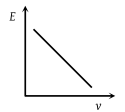Which of the following graphs is correct between kinetic energy (E), potential energy (U) and height (h) from the ground of the particle
(1) 
(2) 
(3) 
(4) 




The force acting on a body moving along x-axis varies with the position of the particle as shown in the fig.
The body is in stable equilibrium at
(1) x = x1
(2) x = x2
(3) both x1 and x2
(4) neither x1 nor x2
The potential energy of a particle varies with distance x as shown in the graph. The force acting on the particle is zero at
(1) C
(2) B
(3) B and C
(4) A and D
Figure shows the F-x graph. Where F is the force applied and x is the distance covered by the body along a straight line path. Given that F is in newton and x in metre, what is the work done ?
(1) 10 J
(2) 20 J
(3) 30 J
(4) 40 J
The force required to stretch a spring varies with the distance as shown in the figure. If the experiment is performed with the above spring of half length, the line OA will
(1) Shift towards F-axis
(2) Shift towards X-axis
(3) Remain as it is
(4) Become double in length
The graph between \(E\) and \(v\) is:
| 1. |  |
2. |  |
| 3. |  |
4. |  |
A body moves from rest with a constant acceleration. Which one of the following graphs represents the variation of its kinetic energy K with the distance travelled x ?
(1)
(2)
(3)
(4)
The diagrams represent the potential energy U as a function of the inter-atomic distance r. Which diagram corresponds to stable molecules found in nature.
(1)
(2)
(3)
(4)
The relationship between the force F and the position x of a body is as shown in the figure. The work done in displacing the body from x = 1 m to x = 5 m will be:
| 1. | 30 J | 2. | 15 J |
| 3. | 25 J | 4. | 20 J |
A particle is placed at the origin and a force F = kx is acting on it (where k is positive constant). If U(0) = 0, the graph of U(x) versus x will be (where U is the potential energy function)
(1)
(2)
(3)
(4)



















